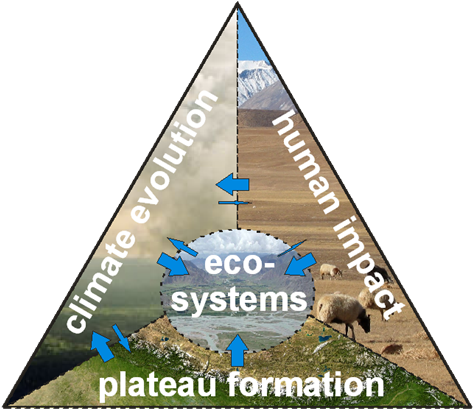Diplomarbeit
Effect of grazing on C partitioning in Tibetan montane pasture revealed by 13CO2 pulse labeling
Silke Hafner (03/2009-03/2010)
Betreuer: Yakov Kuzyakov
Geoökologie, Univ. Bayreuth
Since 1959 settle programs have changed the grazing activity on the Tibetan Plateau. Near the villages grazing pressure increases, leading to land degradation. The opposite effect is visible in remote areas where grazing pressure decreases and thus leads to changes in the vegetation pattern, e.g. tall grasses become more abundant. To clarify the effect of land use changes on the carbon (C) cycle on the Tibetan Plateau, it is necessary to characterize the differences in belowground C allocation and C sequestration of both grazed and ungrazed grassland, to ascertain if the system functions either as C source or sink. In situ 13CO2 pulse labeling was accomplished on 1) a montane Trigonella-Kobresia grassland that is used as winter pasture for yaks, and 2) on a grazing exclosure plot to simulate decreasing grazing pressure, where large grazers have been excluded since 2002, both on the Qinghai-Tibetan Plateau in 3440 m a.s.l. The average partitioning pattern of assimilated C was chased from July 27th until August 22nd, 2009. At the end of the chase period the percentage of assimilated 13C incorporated into structural shoot components did not differ significantly between the grazed and ungrazed plots, amounting to 43% of recovered 13C (1 day after the labeling) in the grazed plots and to 38% 13C of recovery in the ungrazed plots. The dynamics of assimilate allocation in shoots showed an exponential decrease during the chase period in both plots. Recovery of 13C did not differ significantly between grazed and ungrazed plots in any sampling step, which indicates that the dynamics of C allocation in shoots is similar for both grasslands. In the grazed plots however significantly less C was lost by shoot respiration, amounting to 42% of recovered 13C compared to 17%, and significantly more was translocated to belowground pools, amounting to 40% of recovered 13C compared to 20%. Within the belowground pools, the smallest proportion of 13C was incorporated into structural root components in both cases accounting for 2% and 0.6% in the grazed and ungrazed site, respectively. In contrast to the roots, the amount of 13C mineralized to CO2 within 27 days, was significantly higher accounting for 20% of recovered 13C and 9% in the grazed and ungrazed plots, respectively. Under grazed plots, 18% of recovered 13C was not decomposed but remained in the soil. This was significantly more than that of the ungrazed plots amounting to 10%. This finding is in accordance with the significantly higher soil C content and stock in the layer 0 – 5 cm under grazed grassland. The combined decomposition rate of rhizodeposits and organics used for root respiration was determined by fitting a single first-order kinetics to the intensity of 13CO2 efflux from soil during the chase period. The decomposition rate amounted to 0.36 ± 0.09% and 0.18 ± 0.04% of assimilated 13C d-1 for grazed and ungrazed grassland, respectively. Concluding, a positive effect of grazing on C input and sequestration in soil was revealed, since belowground 13C allocation, the amount of 13C remaining in the soil and the soil C content in the layer 0 – 5 cm were significantly higher in the grazed than in the ungrazed plots. Further, the grazing significantly influences the partitioning of below- to aboveground biomass. Belowground biomass was significantly higher in the grazed grassland due to the formation of the Kobresia turf. Keywords: 13C pulse labeling, C partitioning, montane Kobresia pasture, grazing, SOC, Qinghai-Tibetan Plateau

